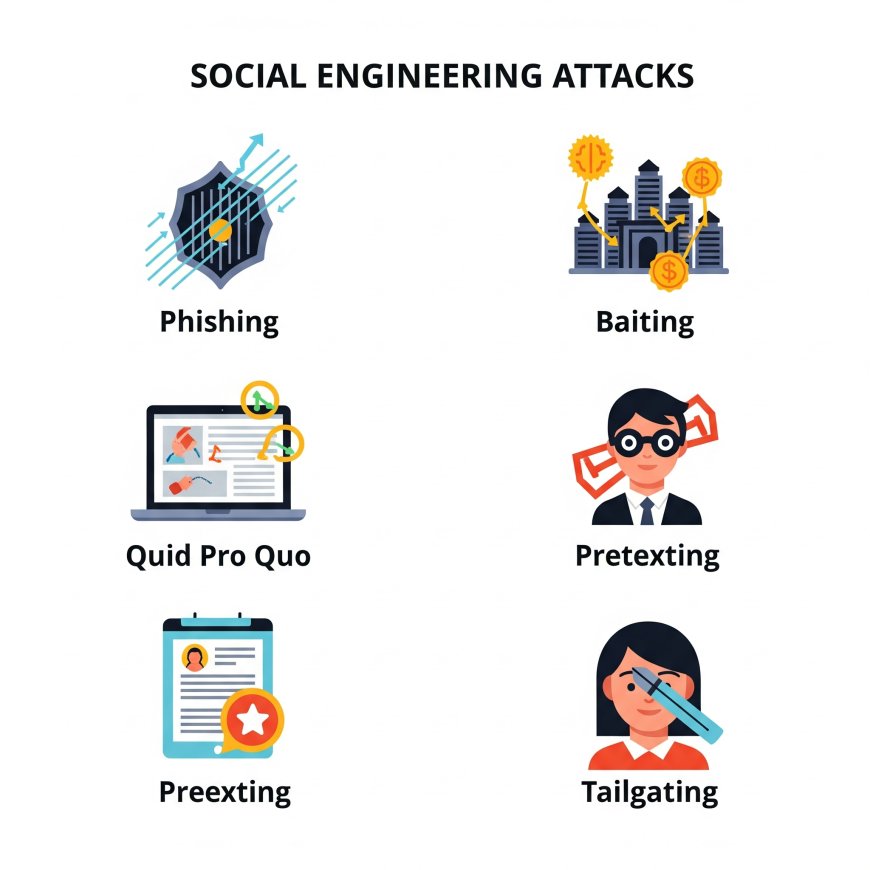Social Engineering Attacks | What They Are, Common Types, Real-World Examples, and How to Protect Yourself
Social engineering attacks manipulate human psychology to gain access to sensitive information, systems, or physical locations. Instead of breaking into systems using code, attackers exploit trust, fear, urgency, or curiosity. This blog explores what social engineering is, common attack types like phishing, baiting, pretexting, and tailgating, along with real-life examples and defense strategies. Understanding the human side of cybersecurity is crucial — because even the strongest firewall can't protect against a well-crafted lie.

Table of Contents
Introduction to Social Engineering
Social engineering is a manipulation technique that exploits human behavior to gain unauthorized access to systems, data, or physical locations. Unlike traditional cyberattacks that rely on technical vulnerabilities, social engineering targets the human element, often considered the weakest link in cybersecurity. Attackers use deception, persuasion, and psychological tactics to trick individuals into revealing sensitive information, such as passwords, financial details, or proprietary data.
With the rise of digital transformation, social engineering attacks have become more sophisticated, leveraging technology and social media to gather information about targets. Understanding these attacks is critical for organizations and individuals to protect against evolving cyber threats.

Types of Social Engineering Attacks
Social engineering attacks come in various forms, each exploiting different aspects of human behavior. Below are the most common types:
| Type | Description |
|---|---|
| Phishing | Fraudulent emails, text messages, or other communications that appear to come from a legitimate source, tricking users into providing sensitive information or clicking malicious links. |
| Vishing | Voice-based phishing attacks conducted over the phone, where attackers impersonate trusted entities to extract information. |
| Smishing | Phishing attacks conducted via SMS, often containing malicious links or requests for sensitive information. |
| Pretexting | Attackers create a fabricated scenario to manipulate victims into providing information or access, often posing as authority figures. |
| Baiting | Luring victims with enticing offers, such as free software or gifts, to trick them into downloading malware or sharing data. |
| Tailgating | Physically following an authorized person into a restricted area to gain unauthorized access. |
| Quid Pro Quo | Offering a benefit or service in exchange for information or access, such as posing as IT support to gain system credentials. |

Common Social Engineering Techniques
Social engineering attacks rely on psychological manipulation techniques to exploit human tendencies. Some common techniques include:
- Authority: Attackers impersonate high-ranking officials or trusted entities to gain compliance.
- Urgency: Creating a sense of urgency to pressure victims into acting quickly without verifying the request.
- Trust: Building rapport with victims to lower their guard, often by researching personal details via social media.
- Curiosity: Using enticing offers or intriguing messages to lure victims into taking action.
- Fear: Threatening victims with consequences, such as account suspension, to coerce them into compliance.
Attackers often combine these techniques with technology, such as email spoofing or deepfake voice technology, to enhance their deception.
Impact of Social Engineering Attacks
Social engineering attacks can have severe consequences for individuals and organizations. These include:
- Financial Losses: Stolen funds, fraudulent transactions, or ransom payments can result in significant financial damage.
- Data Breaches: Unauthorized access to sensitive data, such as customer information or intellectual property, can lead to reputational harm and legal penalties.
- Operational Disruption: Malware or system compromises can disrupt business operations, leading to downtime and lost productivity.
- Identity Theft: Personal information stolen through social engineering can be used for identity fraud, affecting victims' credit and privacy.
- Reputational Damage: Organizations that fall victim to social engineering attacks may lose customer trust and face public backlash.
According to a 2024 cybersecurity report, phishing attacks alone accounted for over 30% of data breaches, highlighting the widespread impact of social engineering.
Prevention and Mitigation Strategies
Preventing social engineering attacks requires a combination of education, technology, and vigilance. Key strategies include:
Employee Training
Regular cybersecurity awareness training can help employees recognize social engineering tactics, such as suspicious emails or phone calls. Simulated phishing exercises can reinforce learning.
Multi-Factor Authentication (MFA)
Implementing MFA adds an extra layer of security, making it harder for attackers to gain access even if credentials are compromised.
Email and Network Security
Use advanced email filtering, anti-malware software, and firewalls to detect and block malicious communications.
Verification Processes
Establish strict verification protocols for sensitive requests, such as financial transactions or password resets, to prevent pretexting.
Social Media Privacy
Encourage employees and individuals to limit the personal information they share on social media to reduce the risk of targeted attacks.
Incident Response Plan
Develop and regularly update an incident response plan to quickly address and mitigate the impact of social engineering attacks.
Real-World Case Studies
The 2020 Twitter Bitcoin Scam
In July 2020, attackers compromised high-profile Twitter accounts through a social engineering attack targeting Twitter employees. By gaining access to internal tools, they posted fraudulent Bitcoin scam messages, resulting in over $100,000 in losses.
The 2016 DNC Phishing Attack
A phishing campaign targeting the Democratic National Committee (DNC) led to the leak of sensitive emails. Attackers used spear-phishing emails to trick employees into entering credentials on a fake login page, highlighting the dangers of targeted social engineering.
The 2023 MGM Resorts Attack
In 2023, a vishing attack targeting MGM Resorts’ IT helpdesk led to a massive ransomware attack. Attackers impersonated employees to gain system access, causing significant operational disruption and financial losses.
Conclusion
Social engineering attacks remain a significant threat in the cybersecurity landscape, exploiting human psychology to bypass even the most robust technical defenses. By understanding the types, techniques, and impacts of these attacks, individuals and organizations can take proactive steps to mitigate risks. Employee training, advanced security measures, and a culture of vigilance are essential to combating social engineering threats. Stay informed, verify suspicious requests, and invest in cybersecurity education to protect against these evolving dangers.
Frequently Asked Questions (FAQ)
What is a social engineering attack?
A social engineering attack is a manipulation technique used by cybercriminals to trick individuals into revealing confidential information or performing harmful actions.
How can I recognize a phishing email?
Phishing emails often contain urgent language, suspicious links, generic greetings, and may ask for sensitive data or login credentials.
What should I do if I suspect a social engineering attack?
Avoid clicking on any links or attachments, report the message to your IT/security team, and verify the sender's identity through official channels.
Can social engineering attacks be prevented?
Yes, through employee training, security awareness programs, and implementing technical safeguards like email filters and multi-factor authentication.
Why are social engineering attacks so effective?
These attacks exploit human psychology — such as fear, trust, curiosity, or urgency — rather than technical vulnerabilities.
What are the common types of social engineering attacks?
Common types include phishing, spear phishing, vishing (voice phishing), smishing (SMS phishing), pretexting, baiting, and tailgating.
Is social engineering only done online?
No, social engineering can occur both online and in-person. For example, tailgating involves physically entering secure areas by manipulating someone.
What is pretexting in social engineering?
Pretexting involves creating a fabricated scenario to convince a target to divulge sensitive information or grant access.
How does baiting work in a social engineering attack?
Baiting lures victims using false promises — like free software or USB drives — which actually contain malware or spyware.
Can antivirus software stop social engineering attacks?
While antivirus software can block malicious files or links, it cannot stop someone from being manipulated into giving away data.
How can businesses protect against social engineering?
By educating employees, conducting regular simulated phishing exercises, enforcing strict access controls, and monitoring suspicious behavior.
What is spear phishing and how is it different from phishing?
Spear phishing is a highly targeted phishing attack aimed at a specific individual or organization, using personalized information.
Are social engineering attacks used in data breaches?
Yes, many data breaches begin with a successful social engineering attack, allowing attackers to gain initial access.
What role does social media play in social engineering?
Attackers use social media to gather personal information that helps them craft believable scams or impersonations.
What is tailgating in cybersecurity?
Tailgating refers to someone following authorized personnel into restricted areas without proper credentials, often by pretending to be an employee or vendor.
What's Your Reaction?
 Like
0
Like
0
 Dislike
0
Dislike
0
 Love
0
Love
0
 Funny
0
Funny
0
 Angry
0
Angry
0
 Sad
0
Sad
0
 Wow
0
Wow
0















